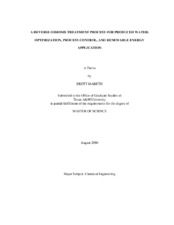| dc.description.abstract | Fresh water resources in many of the world's oil producing regions, such as
western Texas, are scarce, while produced water from oil wells is plentiful, though unfit
for most applications due to high salinity and other contamination. Disposing of this
water is a great expense to oil producers. This research seeks to advance a technology
developed to treat produced water by reverse osmosis and other means to render it
suitable for agricultural or industrial use, while simultaneously reducing disposal costs.
Pilot testing of the process thus far has demonstrated the technology's capability to
produce good-quality water, but process optimization and control were yet to be fully
addressed and are focuses of this work. Also, the use of renewable resources (wind and
solar) are analyzed as potential power sources for the process, and an overview of
reverse osmosis membrane fouling is presented.
A computer model of the process was created using a dynamic simulator, Aspen
Dynamics, to determine energy consumption of various process design alternatives, and
to test control strategies. By preserving the mechanical energy of the concentrate stream
of the reverse osmosis membrane, process energy requirements can be reduced several
fold from that of the current configuration. Process control schemes utilizing basic
feedback control methods with proportional-integral (PI) controllers are proposed, with
the feasibility of the strategy for the most complex process design verified by successful
dynamic simulation. A macro-driven spreadsheet was created to allow for quick and
easy cost comparisons of renewable energy sources in a variety of locations. Using this
tool, wind and solar costs were compared for cities in regions throughout Texas. The
renewable energy resource showing the greatest potential was wind power, with the
analysis showing that in windy regions such as the Texas Panhandle, wind-generated
power costs are approximately equal to those generated with diesel fuel. | en |


